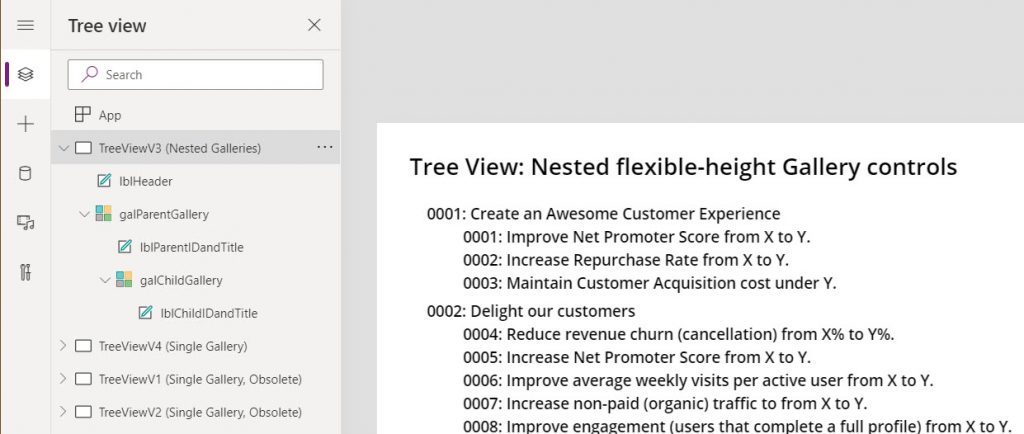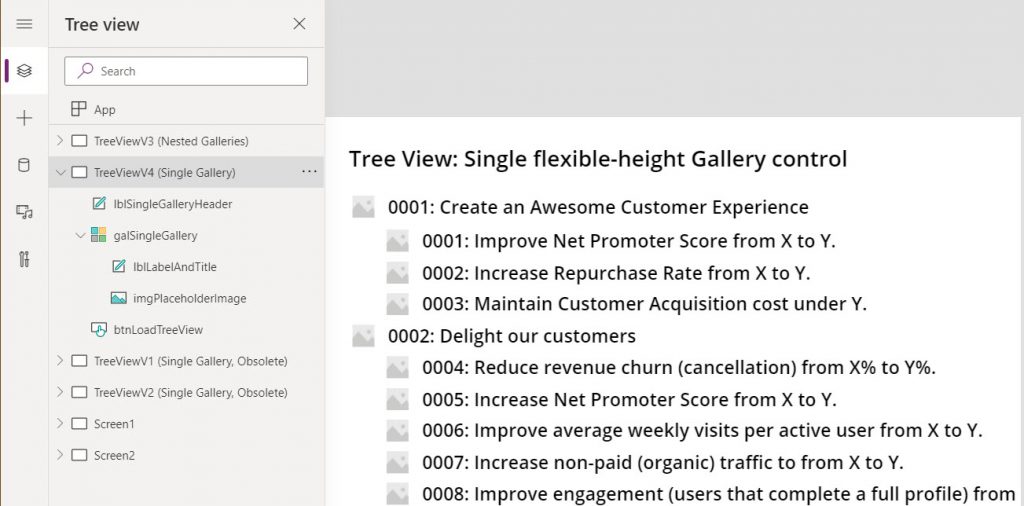- June 10, 2020
- Posted by: Todd Baginski
- Category: How-To

We recently created a Power App with a complex tree view control. Because Power Apps does not provide an out of the box tree view control, we investigated different ways to build one.
There are several ways a tree view can be implemented in Power Apps. After investigating many approaches, we found these patterns work the best.
- Nested flexible-height Gallery controls
- Single flexible-height Gallery control
- Custom Power Apps PCF control (TypeScript)
Nested flexible-height Gallery controls
In this approach we use 2 nested galleries corresponding to the parent and child node levels in the tree view. In this approach, the parent gallery must be a flexible-height gallery. The child gallery is a fixed-height gallery.

Here you can see what the data looks like in the collection bound to the parent Gallery control. This data comes from a CDS entity named Demo Objectives. You will see this entity name in subsequent sections in this article.
| Id | Title |
| 0001 | Create an Awesome Customer Experience |
| 0002 | Delight our customers |
Here you can see what the data looks like in the collection bound to the child Gallery control. This data comes from a CDS entity named Demo Key Results. You will see this entity name in subsequent sections in this article.
| Id | Title | Objective (Lookup) |
| 0001 | Improve Net Promoter Score from X to Y. | 0001 |
| 0002 | Increase Repurchase Rate from X to Y. | 0001 |
| 0003 | Maintain Customer Acquisition cost under Y. | 0001 |
| 0004 | Reduce revenue churn (cancellation) from X% to Y%. | 0002 |
| 0005 | Increase Net Promoter Score from X to Y. | 0002 |
| 0006 | Improve average weekly visits per active user from X to Y. | 0002 |
| 0007 | Increase non-paid (organic) traffic to from X to Y. | 0002 |
| 0008 | Improve engagement (users that complete a full profile) from X to Y. | 0002 |
Here are the important parent gallery settings.
| Property Name | Property Value | Notes |
| Items | ‘Demo Objectives’ | Bind parent collection. |
Here are the important child gallery settings.
| Property Name | Property Value | Notes |
| Items | Filter([@’Demo Key Results’], Objective.Id = ThisItem.Id) | Filter the child collection based on the parent id. |
| TemplateSize | 35 | Row height for each item. |
| TemplatePadding | 0 | Set padding to 0 to avoid potential scroll bar inside the child gallery. |
| Height | CountRows(galChildGallery.AllItems) * galChildGallery.TemplateHeight | Dynamic height for child gallery based on the items count. |
Notes about this approach:
- Only supports displaying items 2 levels deep.
- All items are the same fixed height.
- In Power Apps design mode, each item in the parent gallery might show a gap below the child gallery. It depends on the TemplateSize settings of the parent gallery. This isn’t an issue and the gap will disappear when the Power App is previewed or run.
Single flexible-height Gallery control
In this approach we added Path, Level and Visible metadata columns to the tree view data source so we can organize the nested items by sorting by the Path. We then calculate the indent for each item with the Level, and expand/collapse the child items with the Path and Visible columns.

Here you can see what the data looks like in the collection bound to the Gallery control. Notice in our example here we added the metadata columns to the same sample data source as the previous example.
| Id | Title | Path | Level | Visible |
| 0001 | Create an Awesome Customer Experience | 0001 | 0 | true |
| 0001 | Improve Net Promoter Score from X to Y. | 0001.0001 | 1 | true |
| 0002 | Increase Repurchase Rate from X to Y. | 0001.0002 | 1 | true |
| 0003 | Maintain Customer Acquisition cost under Y. | 0001.0003 | 1 | true |
| 0002 | Delight our customers | 0002 | 0 | true |
| 0004 | Reduce revenue churn (cancellation) from X% to Y%. | 0002.0004 | 1 | true |
| 0005 | Increase Net Promoter Score from X to Y. | 0002.0005 | 1 | true |
| 0006 | Improve average weekly visits per active user from X to Y. | 0002.0006 | 1 | true |
| 0007 | Increase non-paid (organic) traffic to from X to Y. | 0002.0007 | 1 | true |
| 0008 | Improve engagement (users that complete a full profile) from X to Y. | 0002.0008 | 1 | true |
It’s up to you where you store this data. You can store it directly in the source where your tree data comes from (a view in SQL server, a CDS Entity, etc.). Or, you can query the data for your tree from one place and the data for the path and level in another, then merge them into a single collection in the Power App. That’s up to you to decide what works best for your scenario.
To calculate the indent we use Level * [Step].
ClearCollect(
DemoKeyResultsExtended,
AddColumns(
'Demo Key Results',
"ParentId",
Objective.Id /* workaround to get the parent id first as the associated object could only be loaded in this way */
)
);
/* generate tree nodes hierarchy */
Clear(TreeNodes);
ForAll(
'Demo Objectives',
/* append level 0 nodes */
Collect(
TreeNodes,
{
Level: 0,
Path: Id,
Id: Id,
Title: Title,
Visible: true /* expand by default */
}
);
/* append level 1 nodes */
ForAll(
DemoKeyResultsExtended,
If(
ParentId = 'Demo Objectives'[@Id],
Collect(
TreeNodes,
{
Level: 1,
Path: ParentId & "." & Id,
Id: Id,
Title: Title,
Visible: true /* expand by default */
}
)
)
)
);
/* sort nodes by path */
ClearCollect(
TreeNodes,
Sort(
TreeNodes,
Path,
Ascending
)
);
To expand/collapse the items in the tree we compare the path prefix when the user clicks one of the images associated with a node in the tree, like this:
UpdateIf(
TreeNodes,
Path <> ThisItem.Path && StartsWith(
Path,
ThisItem.Path
),
{
Visible: !Visible
}
);
Notes:
- Supports displaying items more than 2 levels deep.
- All items are the same fixed height.
Custom Power Apps PCF Control (TypeScript)
In this approach we made a PCF Control to read data from the data source and render the tree control.
Notes:
- Supports displaying items more than 2 levels deep.
- In this approach you have complete control of everything and you can create the tree to look however you like.
- You must keep in mind how much data you load and the depth of your tree to ensure it performs well.
Hi Todd, this is great information. I wanted to check if th single gallery approach will work for 10+ levels deep.. the tree information will be maintained in SharePoint and we have kind of a complex heirarchy to show. Below is the problem description. Please let me know the best way to get this done.
The Problem Statement :
An external system provides a TSV file which has a list of parent nodes and child nodes which is called Hierarchy Data in regular intervals of time. This File needs to be uploaded into a SharePoint List in a readable logical structure which later has to be used to display a tree list on the power app for the user to select the desired node. However this Hierarchy Data has N:N relationships and is dynamic in nature with regards to new parent and child nodes and multi-level nodes being added . We need a way to display a full-fledged tree list control and there are 10+ hierarchy components which has to be built.
I have never tried 10 levels deep before, but you could certainly try it. Another option is to make a PCF control where you have much more control. You could certainly use PCF to build a tree control 10 levels deep. You might even be able to find one on the https://pcf.gallery web site.
Hello Todd,
Found this very helpful blog.
I have a little bit similar requirement in which I want to display list of all folders, sub folders and documents in tree view in powerapps so that when user click on a folder can view sub-folders and documents inside it.
I am fetching data from power automate to powerapps as I need dynamic way we don’t know number of folders in sharepoint directory .
I have created Power Automate Flow for elevated permissions since in directory users don’t have access to all folders but for navigation it should be visible in PowerApps.
In PowerApps I have displayed all folders,sub folders n documentts in gallery but getting difficulty in displaying them in tree view.
Eg : test—> Parent Folder
Folder1—-> SubFolder1
Test1.pdf ——-> Document
Test2.pdf——-> Document
Folder2—-> SubFolder2
And so on. This should be in dynamic , since no. of folders ,sub folders & documents are not fixed.
Any help would be appreciated.
Thanks in advance.
Hi Hemlata,
Glad to hear it is useful for you! I’m not sure which approach you are using to make the tree control, but whatever you choose, make sure you structure the data so it indicates the parent item. For your case, folders may have parents and documents will have parents. Once you get the data structure defined and all the parents are accounted for, you can follow one of the approaches outlined in the blog post and I suspect it will work quite well for you.
Hi Todd,i tried using your fromula for creating collection ,but facing error .And,is it possible to display 7 levels deep data in single gallery
It’s possible in theory, but I have never tried that may levels before with a gallery. If you don’t have a ton of data, I suspect it would perform OK. You could also use PCF to build a tree control 7 levels deep. You might even be able to find one on the https://pcf.gallery web site.